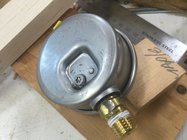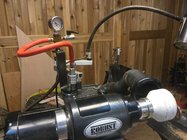The other day I discovered that the oil-filled vacuum gauge that has done yeoman’s service on my lathes for about 15 years has decided to start leaking. I thought initially it was leaking from the o ring around the inlet fitting at the bottom, but after checking closer, it’s leaking from the screws on the back.I gingerly tighten it a little - it barely moved - but the leak is still there. This is a wika gauge - can’t find a lot of information on it in terms of whether anything is serviceable on it. The replacement runs about 4 times what a gauge from Veneer Service costs…
For now I’ve replaced the gauge with one I bought from Veneer Supplies about a decade ago to use with the vacuum pump I use on a carving stand. It’s a dry gauge, but has worked fine for years now. It functions just fine, but I’ll need to replace it so I can still use the carving stand.
My question is - is there any benefit to the oil-filled gauge in either of these applications (lathe vac chuck or carving stand)? The cost difference is 4x - the Wika online runs about $80 - the one from veneer Supplies is $17…not entirely sure how I wound up with the oil-filled version - my Scottish blood doesn’t allow reckless spending, but it’s been many years now…and veneer supplies has everything needed for vac chucking at reasonable prices.
For now I’ve replaced the gauge with one I bought from Veneer Supplies about a decade ago to use with the vacuum pump I use on a carving stand. It’s a dry gauge, but has worked fine for years now. It functions just fine, but I’ll need to replace it so I can still use the carving stand.
My question is - is there any benefit to the oil-filled gauge in either of these applications (lathe vac chuck or carving stand)? The cost difference is 4x - the Wika online runs about $80 - the one from veneer Supplies is $17…not entirely sure how I wound up with the oil-filled version - my Scottish blood doesn’t allow reckless spending, but it’s been many years now…and veneer supplies has everything needed for vac chucking at reasonable prices.
Attachments
Last edited:



